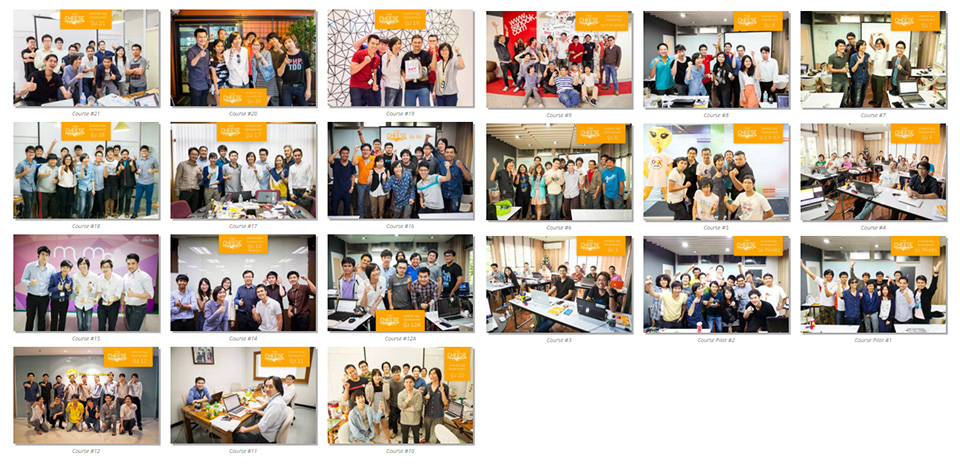-
Lecture 125 : Live @ 500px Application Overview
02:25
-
Lecture 126 : Create a New Project and Structure with MVC
15:36
-
Lecture 127 : Colorize the ActionBar: Material Design Color Pallette
04:32
-
Lecture 128 : Drawer Menu & Hamburger Icon UX Overview
06:31
-
Lecture 129 : Implement Drawer Menu
12:05
-
Lecture 130 : Implement Hamburger Icon
13:02
-
Lecture 131 : Goodbye ActionBar, Say Hi to Toolbar !
11:10
-
Lecture 132 : Create a CustomViewGroup for Photo List Item #1
03:34
-
Lecture 133 : Create a CustomViewGroup for Photo List Item #2
02:32
-
Lecture 134 : Create a CustomViewGroup for Photo List Item #3
06:59
-
Lecture 135 : Hola ListView
09:58
-
Lecture 136 : Memory Consumption Alert: Make View Recycleable
06:36
-
Lecture 137 : Deal with Multiple View Types inside ListView
09:06
-
Lecture 138 : ViewHolder Pattern
03:00
-
Lecture 139 : AdapterView
01:43
-
Lecture 140 : Relation about Memory Consumption and Screen Resolution
01:56
-
Lecture 141 : Fetching Data from Server with Retrofit 2.0 #1: Preparation
01:07
-
Lecture 142 : Retrofit 2.0 #2: Introduction
05:45
-
Lecture 143 : Retrofit 2.0 #3: Retrofit and Gson Converter
10:25
-
Lecture 144 : Retrofit 2.0 #4: Create Data Access Objects (DAO)
08:28
-
Lecture 145 : Retrofit 2.0 #5: Make a Call
15:04
-
Lecture 146 : Context and Asynchronous Callback
03:10
-
Lecture 147 : Show fetched data on ListView #1
06:13
-
Lecture 148 : Show Fetched Data on ListView #2
08:06
-
Lecture 149 : Glide: Make Image Loading easy
10:28
-
Lecture 150 : Glide's Promising Features and Disk Caching Strategy
08:49
-
Lecture 151 : Improve Server Side for Better Image Loading Performance
02:12
-
Lecture 152 : Singleton Lifecycle
09:41
-
Lecture 153 : Eliminate the Global Variable
03:38
-
Lecture 154 : Add an Animation to ListView's Item
09:01
-
Lecture 155 : View Animation Behind the Scene
01:50
-
Lecture 156 : Implementing Pull to Refresh
08:18
-
Lecture 157 : Modify Pull to Refresh for Better Performance #1
17:19
-
Lecture 158 : Singleton Model vs Non-Singleton Model
06:22
-
Lecture 159 : Modify Pull to Refresh for Better Performance #2
09:31
-
Lecture 160 : Improve Pull to Refresh's UX: Maintaining ListView's Scroll Position
08:23
-
Lecture 161 : Improve Pull to Refresh's UX: New Item Indicator
19:59
-
Lecture 162 : Implementing Automatically Load More (Endless Scrolling)
13:48
-
Lecture 163 : Improving Endless Scrolling UX
05:09
-
Lecture 164 : Updating Android Support Library to the latest version
11:00
-
Lecture 165 : Code Quality Improvement: Code Refactoring
13:09
-
Lecture 166 : Handle MainFragment's Lifecycle #1
12:58
-
Lecture 167 : Handle MainFragment's Lifecycle #2
14:36
-
Lecture 168 : Handle MainFragment's Lifecycle #3
11:37
-
Lecture 169 : Updating Library Module [TheCheeseLibrary]
04:23
-
Lecture 170 : Persistant Storage #1: Internal Storage
13:47
-
Lecture 171 : Persistant Storage #2: Data vs Cache
06:32
-
Lecture 172 : Persistant Storage #3: SharedPreference
07:43
-
Lecture 173 : Caching Downloaded Photo Data with SharedPreference
11:11
-
Lecture 174 : ListView's Item Pressed State
08:44
-
Lecture 175 : Handle ListView's Item Click Event
11:58
-
Lecture 176 : Fragment-Activity Communication
14:20
-
Lecture 177 : Up Button
10:09
-
Lecture 178 : ViewPager #1: View Paging
14:04
-
Lecture 179 : ViewPager #2: Fragment Paging Part 1
02:30
-
Lecture 180 : ViewPager #3: Fragment Paging Part 2
09:04
-
Lecture 181 : ViewPager & ViewPagerIndicator
11:00
-
Lecture 182 : Passing Data to PhotoSummaryFragment
09:40
-
Lecture 183 : Finish PhotoSummaryFragment
06:29
-
Lecture 184 : Menu Part 2
08:54
-
Lecture 185 : Menu Part 3: Put Menu in Fragment
05:23
-
Lecture 186 : Bring Up Share Menu with ShareActionProvider
04:23
-
Lecture 187 : How to Share Content to Another Application
14:51
-
Lecture 188 : Make App be Tablet-Supported
14:11


